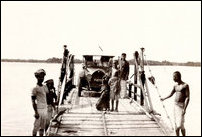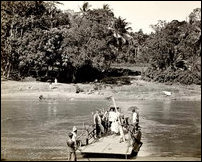Know the Etymology: 166
Place Name of the Day: Thursday, 11 November 2010
Ambalantota, Kapparathota, Ælathota, Kokkuththoduvaay
அம்பலந்தொட்ட, கப்பரதொட்ட, எலதொட்ட, தொடுவை
Ampalantoṭa, Kapparatoṭa, Ælatoṭa, KokkuttoṭuvāyAmbalan+tota
Kappara+thota
Æla+thota
Kokku-thoduvaay
- The ferry-point or jetty having a public resting place
- The port of sailing ships
- The ferry or ford across the brook
- The touching sandbar of cranes leading to the ferry point
| Ampalam | Open space for the use of public, village assembly for transacting village affairs (Tamil, Dravidian Etymological Dictionary 173); place devoted for public use, assemblies etc, a temple (Malayalam DED 173); Ambala: An open shed or hall where public affairs are discussed (Kannada, DED 173); Ambila: House on village green for meetings (Kodagu, DED 173); Ambila, Ambela: The place around or in front of a temple (Tulu, DED 173); Ambalama: A kind of shed built on the roadside for travellers to rest in (Sinhala); Ambara: Sky, space (Sanskrit); Amparam: A place to gather, a place to sleep (Tamil, Pingkalam lexicon 4:260) |
| Tota | Ford, ferry (Sinhala); Tota-munaya: Sea-port, place for landing, site of a ferry, quay (Sinhala); Totu: Path over a river, ford (Sinhala); Totu-pala: Ferry, ford, site of a ferry, place for landing, quay (Sinhala); Tota-kooli: Fare, ferriage (Sinhala; Kooli: Wages, Tamil, DED 1905); Totiya: Man who steers or rows a ferry boat (Sinhala): Thoaddam: Eezham Tamil cognate of Tota (Theavaaram literature of 7th century CE and Cola inscriptions; Example: Maa-thoaddam); Thaandu: Cross, get across, leap across (Tamil, Dravidian Etymological Dictionary 3158); Thaattuka: To get through (Malayalam, DED 3158); Thaadduthal, Thaaddi-viduthal: A ferryman or boatman taking across a river (Tamil, dialectal, Tamil Nadu- Karnataka border); Datu: Cross, pass over, ford (Kannada, DED 3158); Dat: Cross a stream, mountain, road etc; Tot: Cross a boundary etc (Some other Dravidian languages, DED 3158); Thondu: Narrow passage, gap (Tamil, DED 3497); Thondi: Port, emporium (Old Tamil and Malayalam place names); Thoandu: (verb) Unload as a ship (Tamil, DED 3464) |
|
Thodu | Touch, reach, come in contact with, be connected, reach in as well as reach out (Tamil, DED 3481); Thodu-vaay: An almost touching sandbar that leads to a ferry at a narrow mouth of sea (Eezham Tamil place names; Vaay: mouth, Tamil DED 5352); Thoduvai: One that touches or links (Tamil, like the word Mithavai for anything that floats); Thoduwawa: Equivalent to Thoduvaay (Recently Sinhalicised place names in the Puththalam district). Also see column on Valith-thundal for Tudu, Tuda, Tuduva in sinhala and Thundi in Tamil.
|
| Kappara | Ship, sloop, small sailing ship with a single mast (Sinhala); Kappal: Ship, sailing vessel (Tamil, Malayalam, Tulu, DED 1219); Kappali: Ship (Telugu, DED 1219). R and L interchange in many languages (Example: Chaampal / Chaampar) |
| Æla | Brook, rivulet, channel, canal (Sinhala); Aal: Water, flood (Old Tamil, DED 384). Also see column on Ællegoda. |
| Kokku | Common crane, Grus cinerea, stork, paddy bird (Tamil, DED 2i25); Koka: Crane or heron (Sinhala); Kokku: Plural of Koka (Sinhala); Etymologically the word is related to the long beak and curved neck; Kokku: Long beak, bill (Malayalam); Beak, bill (Kannada, Tulu, DED 2034). Also see column on Kukkulaay
|

The location of Kappara-tota at the entrance to the Weligam Bay in Matara district [Image courtesy: Google Earth]
Tota is a popular place name component in Sinhala, meaning a seaport, ferry point, ford or a spot meant for crossing a river etc.
Tota and its Eezham Tamil cognate Thoaddam are very old usages in the place names associated with ports. The latter form appears in the Theavaaram of the Saiva saints of 7th century CE, in their reference to the port-city of Maa-thoaddam (Maa-tota in Sinhala, the present Maanthai in Mannaar district).
The Theavaarams refer to the place as Maa-thoadda-nan-nakar, meaning the good city of the great port. The Chola inscriptions also gives the Tamil form as Maa-thoaddam.
While referring to the port as Maa-tota, another alternative term Maha-patana is also found used in the Sinhala sources to refer to that place, confirming that Patana and Tota are synonyms. (The Tamil/ Dravidian term Paddinam means a port or port-town, DED 3868)
The Sinhala term Tota or its Eezham Tamil form Thoaddam were not found used in the sense of a port or ferry point in the Tamil diction of Tamil Nadu. But Tota also doesnt come from Sanskrit or Prakrit etymology.
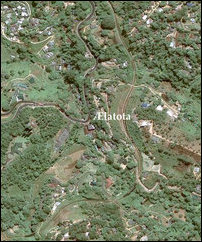
The point where the highway crosses the brook is called Æla-tota [Image courtesy: Google Earth]
Interestingly, close cognates for Tota are found in Malayalam, Kannada and in some other distant Dravidian languages. Datu (cross, pass-over, ford) in Kannada, Thaattu (to get through) in Malayalam, Dat (cross a stream) and Tot (cross a boundary) in some distant Dravidian languages (DED 3158) are some examples. They are related to Thaandu in Tamil (DED 3158).
There is also another Tamil word Thodu (reaching in as well as reaching out, DED 3481) that may be etymologically connected to the Sinhala term Tota.
Tota in Sinhala doesnt always mean a port. In most of the occasions and especially in inland areas Tota means a ferry, ford or a crossing point of a river, rivulet, brook etc.
Another Eezham Tamil place name component, Thodu-vaay, that comes from the root Thodu also seems to be related to Tota. There are similarities between the landscape and functions of Thoduvaay and Tota.
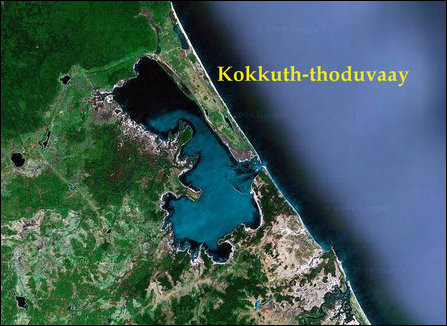
Tha sandbar of Kokkuth-thoduvaay and the ferry to be crossed at the mouth of the lagoon [Image courtesy: Google Earth]
Thodu-vaay is usually a narrow sandbar that reaches out to the ferry point to cross the mouth of a lagoon. The sandbar in these instances functions like a long ford in the coastal communication, except at the mouth that has to be crossed by a ferry.
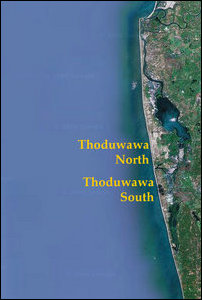
The sandbars of Thoduwawa North and Thoduwawa South separated by the ferry point [Image courtesy: Google Earth]
Thodu a verb in Tamil means to touch as well as to reach, and as adjective means reaching in as well as reaching out (DED 3481). Vaay means mouth (DED 5352).
Thodu-vaay could also be a pronunciation deviation of the word Thoduvai that means the touching or linking landscape. This form of word formation in Tamil is comparable to Mithavai (Mitha: float; Mithavai: a thing that floats).
Thoduwawa seems to be recent Sinhalicisation of Thoduvaay. This component is found in the Puththalam district to the names of landscapes similar to Thoduvaay.
Even though Dravidian in etymology the word formations, Tota, Thoaddam and Thoduvaay, in the sense of their meaning are not found in the diction of Tamil Nadu. The early references coming from Tamil Nadu on Thoaddam are confined only to the place name in the island. Whether another forgotten Dravidian strain was there behind the said word formations needs investigation. The name Thondi for two ancient ports, one in Kerala and another just opposite to Maa-thoaddam also needs attention.
* * *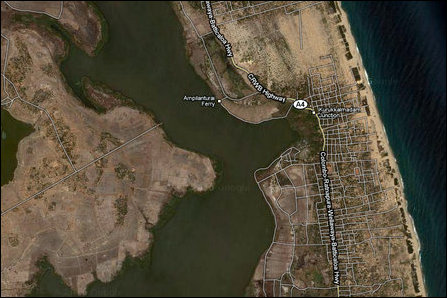
The ferry points usually have Ampalams on either side for the travellers to take rest or to wait for the ferry. Note the place name Ampilan-thur'ai for a ferry point in Batticaloa. [Image courtesy: Google Earth]
Ampalam is a common Dravidian word (DED 173) found in many Dravidian languages meaning a place, raised platform, shed, open hall etc meant for public use. Ambalama in Sinhala means the same.
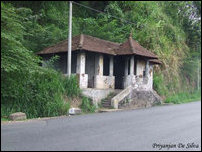
The old building of an Ambalama on the Colombo Kandy Highway for the travellers to take rest at the steep mountain pass of Kadugannawa [Image courtesy: Google Earth, Priyanjan de Silva]
But unlike in South India where it mostly means a place for village assembly, hall in a temple etc, in the Sinhala usage it specifically means a public resting place.
Such public resting places are usually built along highways, roadsides, hill tracks to holy places and at junctions, ferry-points, jetties etc. Thousands of such public places are marked in the topographical sheets of the island.
While Ampalam/ Ambalama is mostly used in Sinhala, and in the Eezham Tamil of the East, the word in common usage for such places in the north is Madam, which has either come from Matha in Sanskrit (hut, cottage, cell etc, especially for an ascetic to retire) or from Maadam in Tamil/ Dravidian (hall, hut, storied house, mansion, DED 4796).
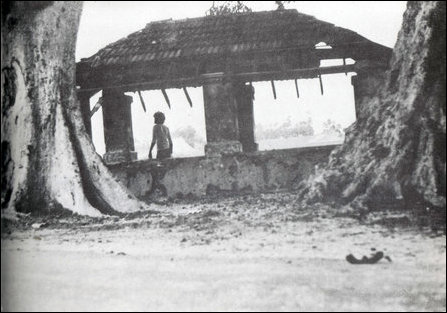
An abandoned roadside Madam in Jaffna Photographed in 1981: Such public resting places are usually a complex of five structures: 1. An open hall of raised platform for the travellers to take rest. 2. Well or a pond of portable water. 3. Water trough for the cattle of the carts and caravans to drink. 4. A short and coarse stone pillar for the cattle to rub and massage their bodies and relax. 5. A structure having platforms of varying heights to suit tall as well as short pedestrians to easily keep their headloads and take it back again without any assistance. Building such resting complexes was considered a great charity. The 5th structure mentioned was often constructed to the memory of a woman died at childbirth. [Image courtesy: Early Settlements in Jaffna]
Kappal found used in Tamil, Malayalam, Tulu etc for a ship or sailing boat is recognized as a Dravidian word (DED 1219). Kappara in Sinhala, meaning a ship or a small sailing boat with a single mast, is a cognate showing L and R interchange.
This is a common interchange in many languages. Even within Tamil one may find Chaampal (ash) could become Chaampar. In Tamil Nadu, spices ground into a paste is called Champaaram. A similar paste is called Champal in Eezham Tamil and in Sinhala. (Chaampaar, often written Sambar, a famous gravy item of Tamil Nadu got its name from the ball of Champaaram paste that is dissolved into it.)
* * *Æla in Sinhala meaning brook, rivulet, canal etc is closely connected to the old Tamil word Aal, meaning water, flood etc. (DED 384). The terms are discussed in some earlier columns. See Ælle-goda and Palaali.
Kokku is another Dravidian word common to Tamil and Sinhala (DED 2125), meaning crane. The word etymologically comes from the conspicuous beak and neck of the bird. See column on Kokkulaay.
* * * Ambalan-tota is a port town in the Ambalantota division of Hambantota district of Southern Province. It is also a ferry point to cross the river Walawe Ganga.
Kappara-thota is at the entrance of the Weligam Bay in the Matara district.
Æla-thota is the point where the A16 Highway crosses a small brook, near Bandarawela, in the Badulla district
Kokkuth-thoduvaay is sand bar that leads to a narrow ferry to cross the mouth of the Kokkulaay lagoon frequented by migrant birds at the border of Mulliththeevu and Trincomalee districts.
* * *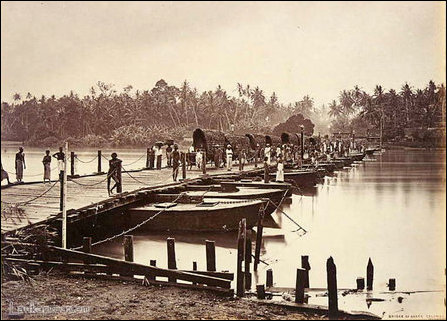
The practice of using lined-up boats as a ford or bridge photographed at Grand Pass, Colombo, in c.1880. Such a bridge was in existence there since Portuguese times. The bridge was built with 21 boats anchored side by side and was 499 feet long says R. L. Brohier. For one-hour everyday, two boats were removed to stop road traffic and to facilitate boat traffic in the river. The nearby locality of the Kelani bridge is still known as Thota-langa in Colombo city, meaning, the adjacent area of the ferry. [Image courtesy: Charles Scowen and Co. Lankapura.com]
The ferry point having a public resting place, Manmunai South West division of Batticaloa district. The pronunciation Ampilan-turai, show closeness to Malayalam.
Turai: Seaport, harbour, way, the spot to get into water (Tamil, DED 3370);
Dura, Tara: Comes in some names of places that are ports (Sinhala place names such as Panadura. Kalutara, Matara etc)
Ambalan-goda: The hillock or bank having a public resting place, Homagama division, Colombo district; Ambalangoda division, Galle district.
Ambalan-watta: The grove or garden having a public resting place, Akmeemana division, Galle district.
Ambalan-oya / Ambalath-thaaru: The stream having a public resting-place on its side, Damana division, Ampaarai district. The place is called by both names. Oya in Sinhala and Aaru in Tamil are synonymus. On the Dravidian etymology of Oya see Galoya.
Ambalan-doowa: The islet, or place surrounded by water, having a public resting place, Panadura division, Kalutara district.
Ampala-valai: The surroundings of the public resting place, Pachchilaippalli division, Kilinochchi district.
Ambala-yaaya: The expanse having a public resting place, Divulapitiya division, Gampaha district.
Ambala-gala: The rocky hill having a public resting place, Medadumbara division, Kandy district.
Ambala: The public resting place, Beliatta division, Hambantota district.
Ambalawa: The public resting place, Mawanella division, Kegalle district.
Aluth-ambalama: The new public resting-place, Hanwella division, Colombo district
Ambalam-mulla: The corner having a public resting place, Katana division, Gampaha district.
Parana-ambalama: The old public resting-place, Wattala division, Gampaha district.
Aandi-ambalama: The public resting place occupied by a religious mendicant. Aandi in Tamil / Malayalam / Kannada means a religious mendicant, especially of the Saiva sect. (DED 356, from Aandavan: god). Aandiyaa in Sinhala means a religious mendicant. The place is in Katana division, Gampaha district.
Gal-ambalama: The public resting place built in stone, Medadumbara division, Kandy district.
Ambalam-pitiya: The mound having a public resting place, Dehiowita division, Kegalle district; There is another at Madampe, Puththalam
Ambala-veli: The open space having a public resting place, Munthal, Puththalam district
* * * Tota: 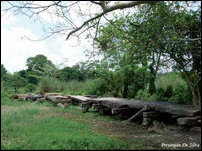
An ancient ford built of stone found at Anuradhapura [Image courtesy: Priyanjan de Silva, The Observer]
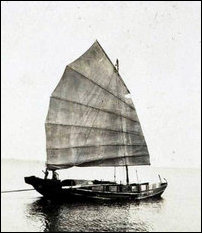
A Sampan photographed in the Philippines by the US Coast Survey in the early 1900s [Image courtesy: ancestry.com]
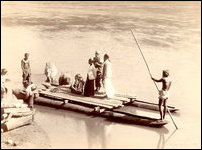
Images of ferry services in the island. From top, Trincomalee, early 20th century, ferry across a river, 1910, a native ferryboat c. 1880-1890, [Image courtesy: Lankapura.com]
The ford built by stone, or the quay built by stones and pebbles, Galle district. Benu; Stone; Benudasa: Stones and pebbles (Sinhala). Ben-tota is a coastal place as well as a place to cross a river that is also called Bentota Ganga.
Hamban-tota: The port frequented by Hamban type of ships, Hambantota division and district. Hamban or Sampan was the name of Chinese and Southeast Asian sailing ships.
Kat-tota: The ferry point of load-carrying porters, the ferry point to transport loads, Gampaha dt.
Rat-tota: The belt-pulled ferry, Matale dt.
Hat-tota-amuna: The bank or dam serving as ford to transport loads, or the cultivation land having a hand-pulled ferry in its locality, Matale dt. In the hand-pulled ferries the passengers themselves have to tug a rope tied between the points and make the ferryboat to move.
Alut-tota: The new ferry point, Puththalam dt.
Kannat-tota: The ferry point at the elevated place having a jungle, Kegalle dt.
Thota-palla: The low ground (bottom of a valley) having a point to cross the river, Ratnapura dt.
Yatiyan-thota: The point to cross the river at the bottom (of a vally), Kegalle dt.
Yatyalla-thota: The locality to cross the stream lower part, Moneragala dt.
Thotala-gala: The rock having a waterfall or stream and a point cross it, Badulla dt.
Kapuhen-thota: The point to cross the river at the field of silk-cotton trees Ratnapura dt.
Lemas-thota: Badulla dt.
Pahamuna-thota: Probably, Pamuna-thota: The ferry point in the endowment land, Badulla dt.
Thoppu-thota: Thoappu-thota: The crossing point at the grove, (Thoappu: grove in Tamil), Puththalam dt.
Thota-muna: The port, quay, landing point or ferry point, Matara Four Gravets, Matara dt. (Muna: End, top, extremity, tip, point (Sinhala); Munai: front, face, appearance, superiority, eminence, point, sharpened end, edge, cape, headland (Tamil, Dravidian Etymological Dictionary 5020)
Kappara-thota: The port or quay for small sailing ships, Matara dt.
Maa-thota-gama: The village of the great port, Matara dt. (Maa-tara itself is equivalent to Maa-thota; Maa: Great; Tara < Turai: Port, DED 3370)
Thota-goda: The rising ground, mound or hillock at the ferry point, Galle dt.
Gin-thota: Jin-thota: The ferry point to cross the river Jin-ganga, Galle dt.
Ela-thota: Æla-thota: The ferry point or ford across the stream, Galle dt.
Hungan-thota: The ferry point of Hunga (a small prickly fish found in rivers), Galle dt.
Balaan-thota: The point to cross the river having Bala (Nothopegia colebroohiana) trees or the Balaa (Bævila, Sida humilis) vegetation, Kandy dt.
Oru-thota: The ferry by boat or canoe, the ford made by lined up boats or canoes, Gampaha dt. There was a practice of using lined and tied boats as a ford to cross. Horu, Oru: Boat, canoe (Sinhala); Ora: Boat (Gond, Dravidian, DED 1039); Paaru: Boat, ship (Tamil, Malayalam, Kannada, DED 4120); Pahri: Boat, ship, coracle, vessel (Tamil, DED 4120); Oada became Hoda in Sanskrit, according to Parpola cited by DED 1039.
* * * Thoduvaay, Thoduvai: Manchath-thoduvaay: The sandbar link or the mouth for ferry crossed by a large cargo ferryboat, or by a small boat, Batticaloa district. Machchuvaa: Small boat: Machchuvaadaa: Cargo boat. It is usually 25 feet wide and 110 feet long.
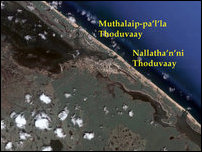
The landscape of Nallathanni-thoduvaay and Muthalaippalla-thoduvaay [Image courtesy: Google Earth]
The sandbar link or the mouth for ferry having potable water, Mullaiththeevu district
Kokkuth-thoduvaay: The sandbar link or the mouth for ferry frequented by cranes (migrant birds), Mullaiththeevu district
Muthalip-pallath-thoduvaay: The sandbar link or the mouth for ferry at the shallows of crocodiles, Mullaiththeevu dt.
Oalaith-thoduvaay: The sandbar link for fishing Oalai-vaalai fish (Trichiurus lepturus), Mannaar Island. Oalai-vaalai is a variety of Vaalai fish, which is a kind of eel looking like long leaves (Oalai). Or, the sandbar link of screw pines (Oalai or Oalaip-poo is a dialectal term for Thaazhai or screw pines. Compare Oalaith-thoduvaay with the place name Oalaik-kudaa, meaning either the bay of T. lepyurus or the bay of screw pines, found on the opposite coast in the Rameswaram Island of Tamil Nadu.
Thoduwawa: The sandbar link with a mouth for ferry, Puththalam district. The Thoduwawa sandbar at the west of Madampe Old Town ends with a narrow mouth of sea, which is a fishing harbour. The narrow mouth, which is a ferry point, separates Thoduwawa North sandbar and Thoduwawa South sandbar.
Meda-thoduwawa: The middle sandbar link with a mouth for ferry, Puththalam district
Mukku-thoduwawa: The angular sandbar link with a mouth for ferry, Puththalam district
Kanda-thoduwawa: The sandbar link with a mouth for ferry, having Kandal (mangrove) vegetation. Puththalam district
* * * Kappal: Kappal-turai: The harbour of sailing ships, Trincomalee Town, Trincomalee district
Kappaladi: The locality of sailing ships, Katpiddi, Puththalam district
First published: Thursday, 11 November 2010, 00:47
Previous columns:

















